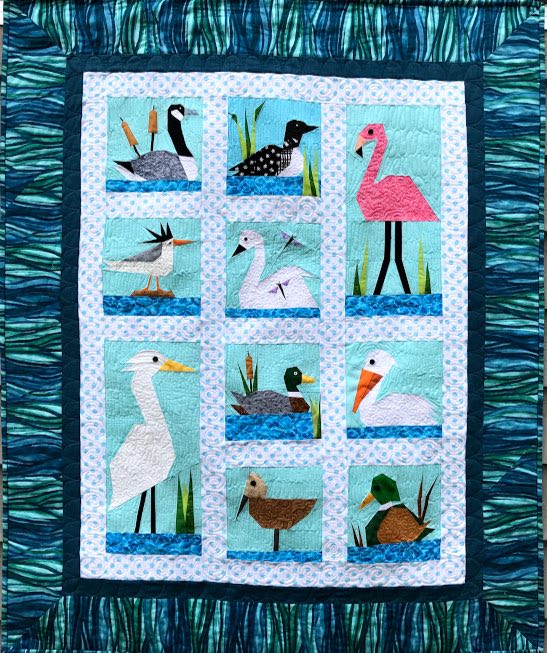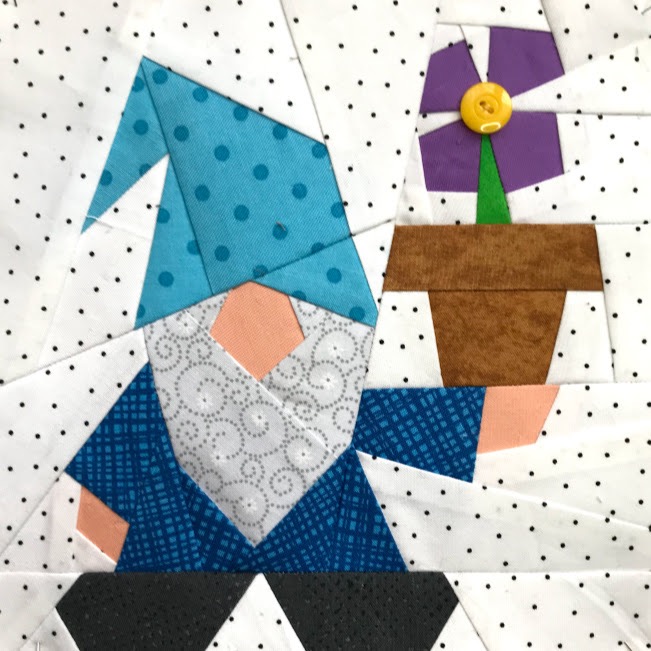With her whimsical animals and happy characters, paper piecing pattern designer Mary Hertel takes you along as she designs quilts for kids and kids-at-heart. Her designs have a youthful and engaging energy that delight viewers of all ages. With so many avenues for learning available today, this art teacher of 35 years believes that anyone can learn to create with paper foundation piecing.

How did you find yourself on an artist’s path? Always there? Lightbulb moment? Dragged kicking and screaming? Evolving?
Creating has always come naturally to me. Even as a child, the only gifts I liked to give were handmade and done with love.
What inspires you to create?
There is a need in me to constantly create new images and ideas. My family is very talented, so some of this may be genetic! I am at my happiest when I am busy, and creating a new design is very fulfilling.
As an Amazon Associate I earn from qualifying purchases. Read more about our affiliate linking policy.
I taught art to students in grades 1-6 for 35 years. So my job required me to create multiple art projects every day. When I retired from teaching, I was anxious to keep creating at that same level. Hence, I now have 500 patterns on Etsy, and have published 6 books, working on #7! It’s in my blood to create.
How does your rural background influence your quilt designs?
You hit the nail on the head with that question. Growing up on a farm with animals and nature everywhere, the rural experience a HUGE influence on my designs. Sketching animals especially, and giving them character, is fun! Also, my 35 years of teaching children’s art and enjoying their artwork is a big influence. I think you can see the whimsical quality of my designs, and they lend themselves very well to juvenile projects.

Have you always been a paper piecer? Why is foundation paper piecing your favorite technique?
No! But I have always been a seamstress. I have sewn clothes for myself and friends since grade school. Then I started quilting and appliquéing in my 20’s. My first paper piecing was done about 15 years ago. After trying it, I then became obsessed with its puzzle-like nature. Looking for paper pieced patterns at that time was difficult. I was not finding the type of patterns I like to sew, thus I started to create my own.
What do you do differently? What is your signature that makes your work stand out as yours?
My designs have a whimsical quality, cute and fun! Designing geometric quilts doesn’t interest me at all. I love working with images. I like to call my designs WONKY!

What is the most important takeaway you want people to gain from your books and patterns, especially your new title, Sew Cute Baby Animals: Mix & Match 17 Paper Pieced Blocks; 6 Nursery Projects?
I am so happy that my customers are LOVING my new book. I was influenced by the “Big Eye” artist Margaret Keane, so I have exaggerated the eyes in the animals to make them look sweet and adorable, you know, just like babies! Since this is a book full of baby projects, it was important to step back from using buttons in my designs, as I often resort to buttons for eyes to keep my patterns easy to do. Instead, all of the blocks in my newest book have only paper piecing, no buttons.
Do you have a dedicated space for creating? If so, what does it look like?
A mess…enough about that!

What is your favorite storage tip for your fabric and creative supplies?
Divide your scraps by color. When I am creating I keep ALL of my bins of fabric around me, so I can grab colors and fabrics as I work.
What are the indispensable tools and materials in your studio? How do they improve your work?
For paper piecing, I use a 12” add-a-quarter ruler. I love my wool mat for pressing and pinning my pieces to while I work.
For designing, I use a thin LED tracing box. I will redo my sketches a number of times until I like the finished sketch. Having a tracing box helps me transition the sketch without starting completely over each time.


Do you use a sketchbook or journal? How does that help your work develop?
Yes! I sketch in 4”x 4” thumbnails in my sketchbook, then blow them up to the desired size. Almost all of my blocks finish at 7½”x 7½” for 2 reasons.
1) Keeping all my blocks consistent means that any image can be used in any of my patterns.
2) Customers can easily copy my patterns on their home printers. Each block fits on a standard size paper.
What plays in the background while you work? Silence? Music, audiobooks, podcasts, movies? If so, what kind?
TV.
When it comes to creating, are you more of a planner or an improviser?
I do both.
Can you tell us about the inspiration and process of one of your designs? How does a new work come about?
A lot of my designs are customer driven. They email me asking for certain images. If I agree that the idea is worth pursuing, then I will try to create it. I am always up for a challenge, and the only ideas I would turn down are a) I already have a very similar block; b) the image they want has a copyright, such as a popular cartoon; c) the image is much better suited to using an appliqué technique. Otherwise, I will tackle just about any idea.
Sometimes I am motivated by a trip I have taken. For instance, my Woodland Wildflowers pattern was designed while we did the Lake Superior Circle Tour. And my Under the Sea quilt was designed when I was visiting my sister in Florida.
I also pick my editor’s brains as to “What do customers want?”
What (or who) has been your biggest inspiration in keeping your creative energy going?
Definitely my customers…for example, I was emailed last week by a gentleman who had served in the Air Force in the Korean War. He wanted a Military Gnome saluting. He was such a sweet man, and was sharing some of his experiences. My customers are fabulous!
What was the biggest challenge that you encountered on your creative journey? What did you learn from it?
When I was just beginning to write books, the first publisher I approached loved my patterns, but turned me down because at the time I had very few social media followers. They were not willing to take a chance on me. I was super disappointed, but the next publisher I pursued was not at all concerned with the social media aspect, and I was accepted with flying colors. Some years later, I was designing magazine articles for the same company that had turned my book down. Their editor said, “Why aren’t you publishing your books with us? We love them!” Just goes to show, you should stick up for yourself, and if you meet an obstacle in your creative journey, accept it and move on. Success may be just around the corner.
Do you think that creativity comes naturally to people, or do you think creativity is a skill that people can learn?
Coming from teaching art for 35 years, I believe art methods can be taught, but it sure is easier if students arrive with some natural skill! I have found that everyone is creative in their own way, be that with fabric, paint, wood or numbers!

How can people overcome the challenges they feel to their creative ability?
We are very lucky to live in an age where there are so many different avenues for learning. If following a written pattern doesn’t work for you, try watching a video, or enroll in a class. We all learn differently.
Tell us about your blog and/or website. What do you hope people will gain by visiting?
My blog is madebymarney.com. I use it to share my new creations with my customers and friends. I also have free tutorial videos to teach paper piecing and quilting techniques. So you will find my products and my teaching videos on my blog. I also like to occasionally share photos of projects my customers have created using my patterns.
Check out this video that gives you the basics of paper-piecing.
Interview posted March 2022
Browse through more foundation piecing inspiration and projects on Create Whimsy.
